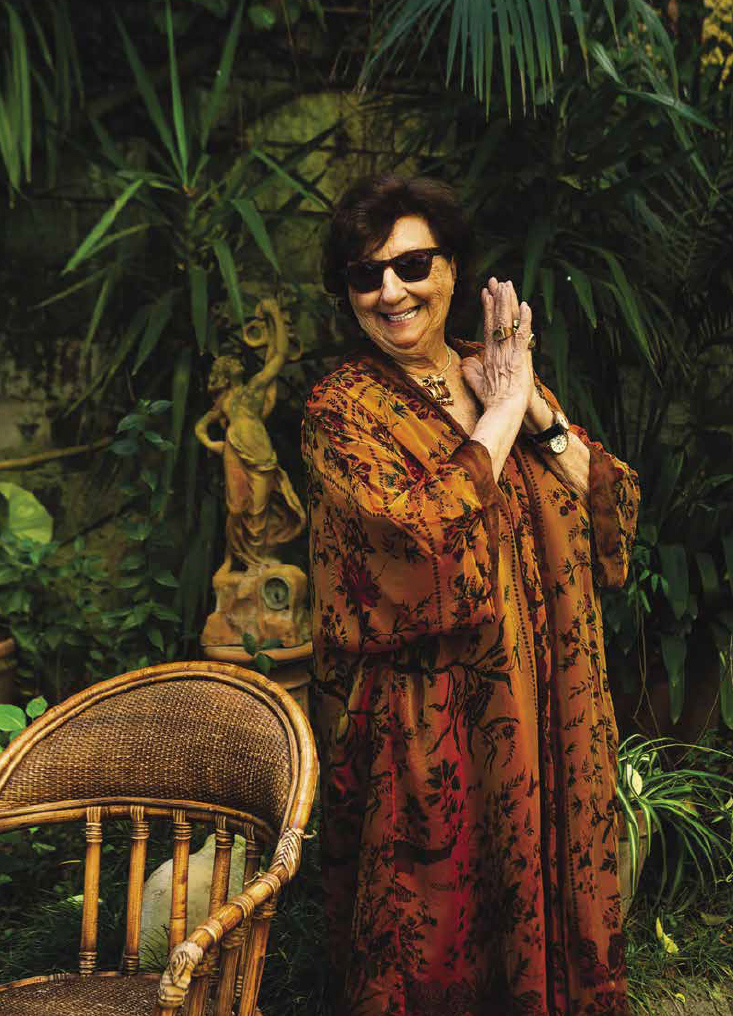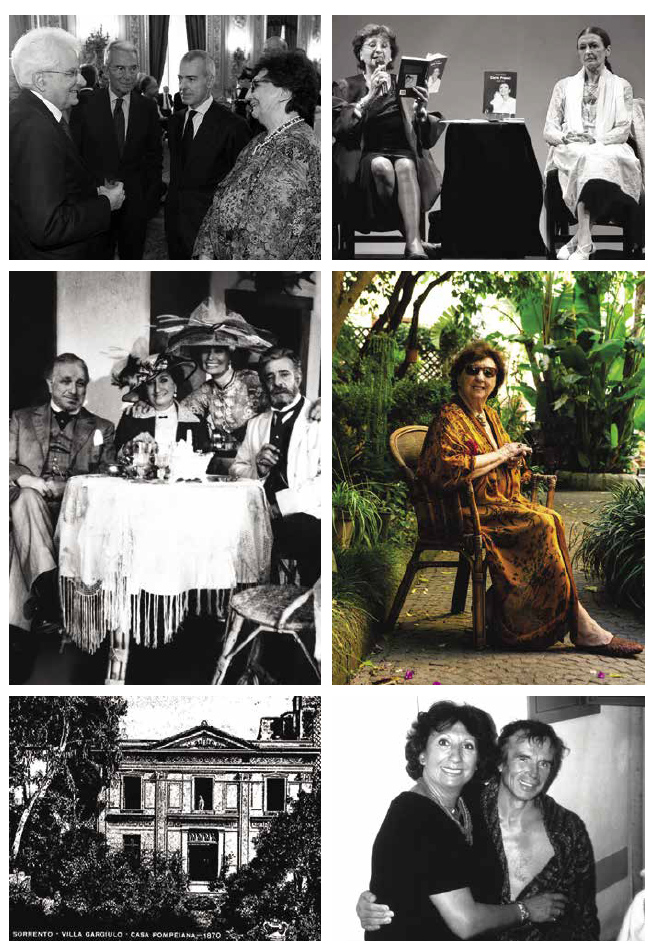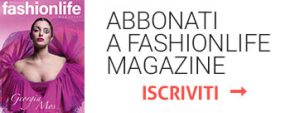An actress with Eduardo, she recently returned to the set with Alessandro Gassmann in “I Bastardi di Pizzofalcone.” His life, like the title of his latest book, is always a “Shot in the arm.” Close encounter with a great eyewitness of our time.

Encounter as a hypothesis of storytelling, and as a vocation: by culture, by birth, by education.
Meetings as a path of life and work.
From Sorrento onward, with the enthusiasm and cheerfulness of her childhood years with Donna Elena Fasulo of Torrelupara (her mother), Giuliana Gargiulo lives with almost nineteenth-century passion but with the rigor and tenacious, lively attention of a thoroughly contemporary woman.
Collecting photographs, preserving, remembering help her place herself in space and time, always grappling with a story to tell, or new stories to write. Giuliana sees and tells in her own way, always speaking, memory and words are her eternal traveling companions, her voice is always joyful. Like his life. A long artistic and professional life, narrated by herself first in the mini-book “Una storia mia” (2003) and more extensively in “Colpo di scena” (Graus Editore, 2016): which began with the experience made in the theater with Eduardo, immediately after the meeting with Vittorio De Sica on the occasion of the film “Bread, Love and…”, and then continued, after marriage and two daughters, with meetings, travels, presentations, interviews (eleven thousand, published in seventy different national and regional newspapers), positions (Board member for a decade of the Teatro Stabile di Napoli, AIRC and Friends of the San Carlo Council…), presentations, events, films, radio programs and what not.
Unstoppable and optimistic, as tireless as she was determined, Giuliana made life, marked also by not a few mishaps along the way, an opportunity for participation.
A careful interviewer of protagonists from the worlds of entertainment, culture, and art, she makes no distinction in her in-depth coverage between Nobel Prize winners (Renato Dulbecco, Rita Levi Montalcini…) and Oscars (Piero Tosi, Loren, Liz Taylor, De Sica, Fellini, Nicola Piovani…) and young debutant or emerging artists, as long as she senses or intercepts their talent.
“And if you cannot the life you desire, seek at least this as far as it lies within you: do not squander it…(Kostantinos Kavafis)”
What memories do you have of your childhood? What kind of little girl were you?
I was fortunate and privileged to have been born in Sorrento, in Villa Gargiulo, in a family with a grandfather writer, Manfredi Fasulo, grandson of Nicholas, lawyer and martyr of the Revolution of 1799, father an engineer with a passion for painting, son and grandson of the “reinventors” of the tarsia sorrentina, an uncle in London who loved opera, and above all a wonderful mother, Elena, a free and generous thinking and open-minded woman. Sorrento was a small “gentle” town, loved and frequented by royalty from half of Europe, without a perfumery but with a continuous transit of international personalities, including for the “Cinema Meetings.” Many guests arrived in the living room of the house, Roberto Rossellini, Eduardo, Roberto Pane (while speaking he points to the portrait that the great architect and writer wanted to dedicate to his mother, ed.)… And, one fine day, even actor Rossano Brazzi, who was leaving for the United States to film “Little Women” with Elisabeth Taylor and “Three Money in the Fountain” with Katharine Hepburn…can you imagine what didn’t set off, in years in to which there was not even television, in the mind of a 9-year-old girl who, almost every day, went to the movies with her mother! Brazzi asked me what he could give me from Hollywood and I, without hesitation, I said, “Everything you need to become an actress!” That “everything” came, a few months later, a box of tricks from Hollywood, which, if in the country became a subject of “amazement,” for me was happiness!
Your first memory as a woman?
I think it coincides with the wedding in Sorrento at the Church of the Servants of Mary, which marked all the family happenings.
You wrote in your latest book “Shot in the Dark” that as a child you dreamed of doing two things: being a journalist and an actress. So it was. Today, even through your tireless activity, theater always seems to be the great reference of life for you.
Theater has been and continues to be my great love. By paradox I always say that I would like a tomb in the shape of an armchair! In the living room of the house in Naples ne I have a “stalls” one from the San Carlo Theater, but I also have a huge silhouette of “Gone with the Wind” with Clark Gable and Vivien Leigh kissing! Then lots of playbills, sketches, dedications, photographs, memorabilia… Theater and cinema are my habitat. When I attend a performance — of course with my own predilections — I feel that I am in “my” place, in my place of the soul.
You made your theater debut in the “Scarpettiana,” the legendary company of Eduardo de Filippo. What do you take with you from that experience?
Eduardo was a great teacher. A near-fatal encounter for the minor I was. My life has been marked by great teachers and great examples. As a journalist, the question I always ask the protagonists of my interviews is, “Who taught you the most in life?”, a concept I continue to pass on to daughters, grandchildren, and close friends. Examples and teachers matter in life more than anything else, I even believe that they can affect a person’s formation, beyond affection, of course, even more than family or loves. I had many teachers, starting with Gaetano Salvemini who, at 13 years old, I did not know was the greatest Italian historian. After twenty years in America, the professor had chosen to retire to “La Rufola,” the large villa at the Capo di Sorrento where Marchesa Titina Benzoni Ruffino and her daughter Giuliana used to receive the greatest exponents of the cultural world and which I, as a child, attended with my parents. Salvemini gave my “culture” a hard time. The professor and Eduardo continue to be omnipresent in my education, in my uprightness of mind, in my way of looking at life, always a great opportunity! I love life very much.
What do you miss about your work as an actress?
I must admit that so many years later, I am languishing. Recently, on RaiUno, I was featured in an episode of “The Bastards of Pizzofalcone.” I was playing Rosetta Tortora, an aunt grief-stricken by the killing of her niece, and I loved being back in the dressing room, on the set, working with director Alessandro D’Alatri, with Alessandro Gassman, whom I have known since childhood, with a cast full of talented Neapolitan actors and with such a precise and professional production. With the right script, who knows, I might even decide to return….

Meaningful encounters seem to be the constant in your life: relationships first initiated in professional terms and then translated into relationships of great and solid friendship.
It is. Piero Tosi, great master of world cinema, absolute genius, “Academy Award for Costume Design,” marked my most recent years. I discovered his immense work, his almost pictorial research with “Senso” by Luchino Visconti, with Alida Valli. Later in a supporting role in Liliana Cavani’s film “La Pelle,” based on Curzio Malaparte’s book of the same name, I was dressed by him! I was shooting a scene with Marcello Mastroianni and Claudia Cardinale while Piero checked that everything was perfect, even the orchid at the neckline that he wanted to change several times! Since then the meetings have multiplied, until the interviews have turned into the many occasions of friendship shared in his Roman home… very private. Until his passing Piero Tosi was a huge reference of culture and affection!
Friendship is therefore one of the absolute values for you.
No doubt. A great and dear friend was Graziella Lonardi Buontempo, a tireless organizer of cultural events related to contemporary art. I miss her on a daily basis, and I was happy that her granddaughter Gabriella Buontempo, now a TV producer extraordinaire, dedicated a film to her in which I am very much present. With Graziella I shared so much, the first trips to India, Neapolitan cinema in New York, summer stays in Favignana and Sabaudia, for years the Malaparte Prize in Capri… I interviewed her for my first book, “Napoli Donna.” Of different characters, we shared an approach to life of great curiosity, cultural interest, with a taste for discovery and knowledge. We were never still, always wanting to do something… Graziella, going further, had experienced the art world and I had experienced journalism. Of rare beauty, he knew how to cultivate opportunities and encounters with artists. It was she who sought me out in the 1970s, knowing of my friendship with Carla Fracci, whom she wanted to meet. One day he phoned me, “You’re in Sorrento, why don’t you come visit me in Capri?”
The sense of friendship between you and Carla Fracci is also immortalized in a very rare book, published a few years ago, developed into an original alphabet tracing a very special portrait of the great etoile, divided by headings, from topic to topic, “From A to Z,” as the title reads (Graus Editions).
Since September 1, 1958, without interruption, Carla has been central in my life. I was at the Piccolo Teatro in Milan for the start of rehearsals for the season’s inaugural show, Altavilla’s “Pulcinella in search of his fortune on the streets of Naples,” directed by Eduardo, scenes by Mario Chiari, assistant directors Beppe Menegatti and Gilberto Tofano. Thus began, on the stage of Via Rovello, my friendship with Beppe, which would be followed by my friendship with Carla. The first time I saw it was in photographs. At a rehearsal interval Beppe asked me to accompany him to the newsstand in Castle Square to buy “Gente.” The weekly magazine features a large portrait of Carla, photographed by Tony Armstrong Jones, who became Earl of Snowdon for his marriage to Margaret of England. Since then, and until its recent end, the friendship has never stopped. Together we traveled, talked, lived. With Carla I crossed the world, not only geographically, but of dance. In Hollywood with Franco Zeffirelli and Jack Nicholson, in Washington with President Gerald Ford and Secretary of State Kissinger, then in New York with Clive Barnes, powerful critic of the New York Times, and again London, Paris, Helsinki… I have seen her dance in shows of all kinds, attended rehearsals and classes, learned how to recognize a step and understand its difficulties, identified the talent and qualities needed to dance, followed her in television interviews and public speaking… Through Carla I also understood character determination and aerial ability to dance. Art, success, quality, harmony, and good taste accompanied Carla’s natural good sense, a great strength of hers: in career as in life. I don’t think I ever heard her raise her voice, even though, with competence and intransigence, she repeatedly clarified the meaning of things. For years it was rather silent. He listened attentively and was silent most of the time. Over the decades of our friendship, among the most beautiful and cherished of my life, never a rift, a misunderstanding, an anger. Although temperament was never lacking in either of them.
Was (it) difficult to be friends with a world star like Carla Fracci?
Difficult ever, she was a light, the immense dancer she was, the only one who danced on five continents… We lived loving family, work, friends, her following her son Francesco, me my Eleonora and Elisabetta. A friendship strong in sincerity and loyalty. With uncommon fellowship we have shared music, entertainment, theater, performances, museums, meetings, readings, projects… Even living in different cities, important occasions have always seen us together: children’s weddings, grand premieres, theater celebrations, galas, family anniversaries. I think I have seen Carla in “Giselle,” and not only in Italy, at least a hundred times, paired with great partners-Rudolf Nureyev, Vladimir Vassiliev, Paolo Bortoluzzi, Gheorghe Iancu, Ivan Nagy, Misha Baryšnikov. In fifty or so years of acquaintance, we have never lost sight of each other, always cultivating our friendship.
The world of dance also entered your life with Russian ballet dancer Rudolf Nureyev.
Unique and unforgettable! The most difficult person I have ever met! So scarred by pain, he was irrepressible, like a child: it was not possible to predict his reactions, which were often excessive, nor was it possible to calm him down… I saw him suffering like a desperate man. But it was normal: at the age of 21, in Paris, for the first time outside Soviet Russia, decided in a matter of minutes to give up her mother, her land, her dance school, her friends … throwing herself into the arms of a French police officer and asking for political asylum! Once, after a triumph in the theater, before entering the White House, I asked him, “Are you happy, Rudolf? Are you proud of this success? Boos of ‘bravo,’ twenty minutes of applause, so many accolades…” Two tears marked his face and, in his simple Italian, he said, “What does it matter to me, if I can’t see my mama?” After thirty-nine years away Rudolf, by Gorbachev’s concession, was able to return to Russia for a day and see his mother who was dying and, after 24 hours, passed away.
How did you meet each other?
Our first meeting is erased by the years we then shared. The first time was at La Fenice in Venice, I was a ballet enthusiast who asked him for his autograph, which he immortalized for us in a photo that I still keep. The second was at La Scala in Milan, he as Prince Albrecht in one of the most beautiful editions of “Giselle,” with Carla. Unreachable, beautiful, he ran across the stage making the big, princely cape fly: magic. We met after the show for dinner at Carla’s house, and from there it was a succession of interviews and performances. The friendship was born when he decided to buy the Isle of Gauls, in the sea off Positano. Our summers flew by… He used to call me “Gioiosa,” we shared extraordinary occasions such as the arrival, on “his” island, of President Vaclav Havel, Leonardo Mondadori, Lina Wertmüller and many others. One night I convinced him to go see Carla who was going to dance in Salerno. At dusk we set off from the island in a motor boat that went slowly over the sea, and I was talking, talking, and telling about the coast, Sorrento and Eduardo on the other island nearby, Isca, when he at one point said, “Please don’t talk anymore Gioiosa, let’s listen to the silence of the sea.”
In Sorrento, the connection with Renzo Arbore dates back to his teenage years.
Yes. Renzo is a kind of brother. He barged into the life of Gerardo, my older brother, when we were studying in Naples. We lived on Martucci Street and he lived on Amedeo Square, a short walk away. They were united by an immense passion for jazz; they were both crazy fanatics lost for Louis Armstrong: Gerardo played the trombone and Renzo played the clarinet. An acquaintance that soon turned into a very strong friendship. Renzo was often our guest at Villa Gargiulo. I listened to a preview of many of his compositions in the living room at home, some still unpublished, including “I’m Old, Scraggly and Paralytic,” which I always urge him to publish. Renzo is a friend of the heart, he made the great journey he did but we never lost each other.
Text: Ciro Cacciola




